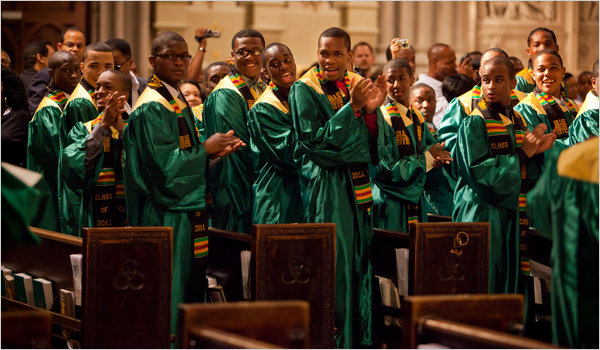On Religion All those trappings of longevity, the bronze doors and marble pulpit and stained glass, were illusory. The graduation ceremony on May 27 was the last ever for Rice, which is being closed, and the event was most significant as a symbol of the continuing contraction of Roman Catholic education in the urban settings where it has been most needed.
Over the last half-century, the number of Catholic schools has fallen to 7,000 from about 13,000, and their enrollment to barely two million children from more than five million. A disproportionate share of the damage has come in big cities. So when a landmark topples as Rice did — and as Cardinal Dougherty High School did in Philadelphia last year, and as Daniel Murphy High School did in Los Angeles two years before that — it ought to provoke more than sentimentality or tears. It ought to sound an alarm about a slow-motion crisis in American education. To grasp what is being lost, one needed only to look through the roster in the graduation program for Rice. With a student body that is 98 percent black or Hispanic, with 80 percent of its students requiring financial aid, virtually every graduating senior was bound for college: Penn, Cincinnati, Holy Cross, Fairfield, Iona. Four of the Rice men had received scholarships in excess of $150,000. (Full disclosure: I wrote the introduction to a 2009 book about Rice, “The Street Stops Here,” by Patrick McCloskey.) “It’s unbelievable that you have a school that graduates 100 percent of the kids and sends them to college and shuts the door,” said Skip Branch, a basketball coach at the school. His own son, Floyd, graduated from Rice in 2002 and went on to Middlebury College with a full academic scholarship. Even as he congratulated the latest crop, Mr. Branch passed out fliers on the cathedral steps urging Rice families to call the Archdiocese of New York to protest. Nearby, shortly before the ceremony began, two dozen seniors broke into a spontaneous chant: “Save Rice! Save Rice!” Well within earshot was Steven Strong, a bus driver and the father of three Rice students. His eldest, Steve, is a senior at Penn State. The middle one, Dominick, would be graduating on this evening. And the youngest, Damian — well, as a sophomore at Rice he was now an educational orphan. Mr. Strong said, “For a school to be there for so many years and close at such a crucial time ...” He never finished the sentence. There are reasons, of course, for closing Rice and schools like it, and those reasons fall into a familiar pattern: declining enrollment; less money from parish or diocesan coffers; far fewer clergy members to serve as an unpaid administrative and teaching force; annual tuition that, typically in the mid-four figures, is too expensive for many working-poor and working-class families yet far short of actual per-student costs. In the case of Rice, another even grimmer factor played a role in the closing. The Christian Brothers religious order, which founded and operated Rice, filed for bankruptcy in late April, collapsing under the weight of payments to victims of sexual abuse by the order’s members, particularly in the Seattle area. With the exception of the molesting scandal in the Catholic Church, though, most of the obstacles for Catholic schools have been amply visible for decades. The dioceses, religious orders or parishes that run schools have had no reason to be blindsided. “Rice is the victim of a business model that is no longer sustainable,” said Francis J. Butler, president of Foundations and Donors Interested in Catholic Activities, a philanthropic group that is involved in education. “It’s a case study for so many similarly situated schools. It shows how necessary it is for these schools to have a broader base of resources, of partners to carry the load.” However belatedly, parts of Catholic clergy and laity have tried to develop new models. The Nativity Miguel and Cristo Rey networks have opened dozens of small, academically intensive middle and high schools. The Big Shoulders Fund in Chicago provides Catholic schools there with scholarship money, in-kind services like construction, and ties to arts organizations, among other benefits. Arizona gives a tax credit to individuals who donate money for tuition assistance through state-certified groups, including one funneling such aid to Catholic-school families. None of these efforts, promising and idealistic as they may be, have come close to halting, much less reversing, the pattern of retrenchment. While 34 new Catholic schools opened in the 2010-11 academic year, 172 closed or were consolidated, and nearly 2,000 had a waiting list for admission, according to data from the National Catholic Educational Association. The 24 Cristo Rey high schools together have 6,500 pupils — only a couple of hundred more than Philadelphia’s Cardinal Dougherty High alone had at its height in the 1960s. To put it in personal terms, when Michael Gecan was growing up on the West Side of Chicago in the 1950s and 1960s, the area had 10 parish schools enrolling about 10,000 students in total. These days, when he returns there as a national organizer for the Industrial Areas Foundation, he finds seven or eight much smaller schools with a collective student population of about 1,000. “Given all the money that’s been raised for charter schools — from the Gates Foundation, from Eli Broad, from hedge fund managers — I find it perplexing that Catholics can’t raise money for their own schools that have a track record of success,” Mr. Gecan said. “I don’t think they’ve tried hard enough. They’ve lost focus on their core mission.” His opinion was widely shared on Rice’s day of celebration and mourning. “The window of opportunity is so small,” said Tawanda Walker-Hall, whose son, James, was graduating. “And the need is so great.” sgf1@columbia.edu
|
Any original material on these pages is copyright © BishopAccountability.org 2004. Reproduce freely with attribution.
